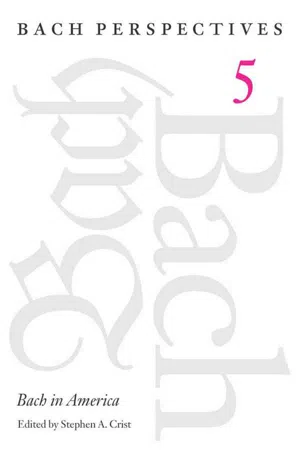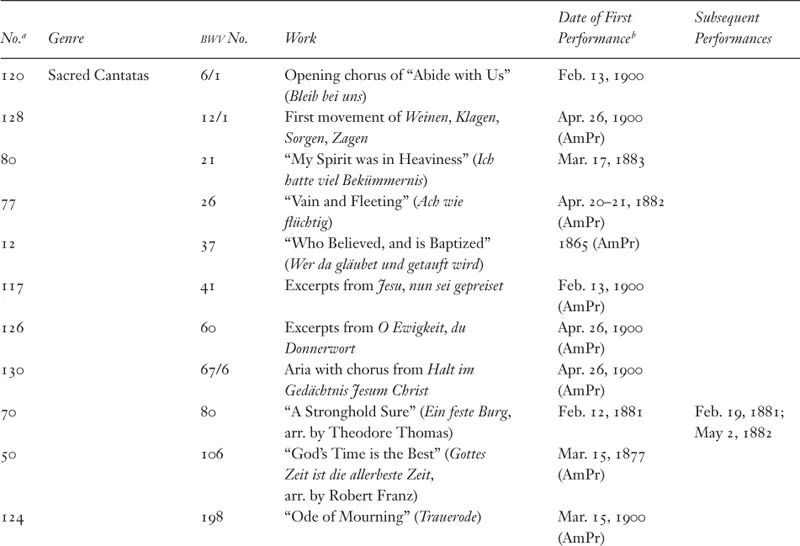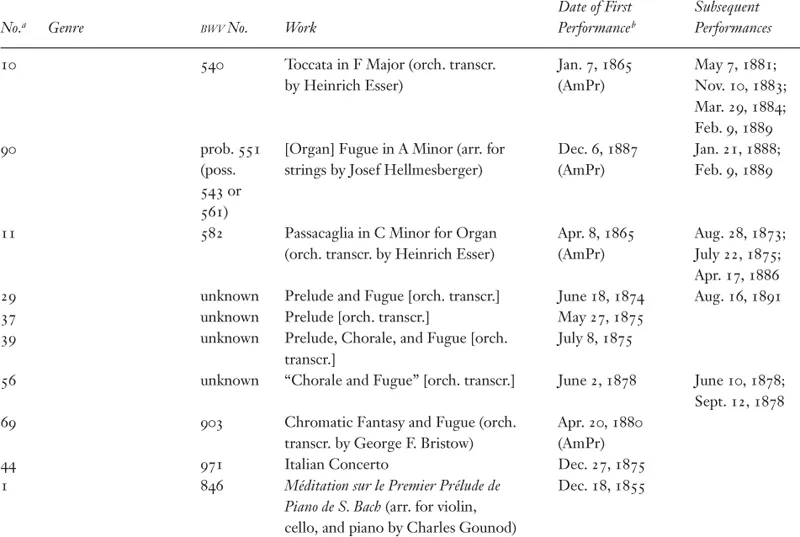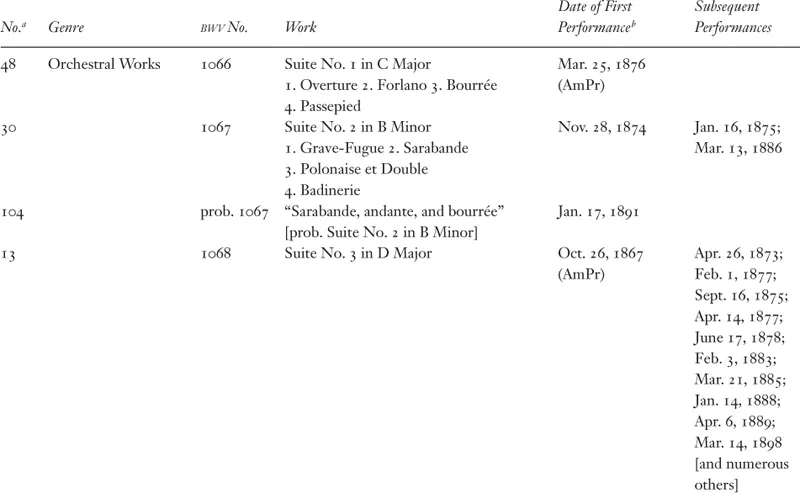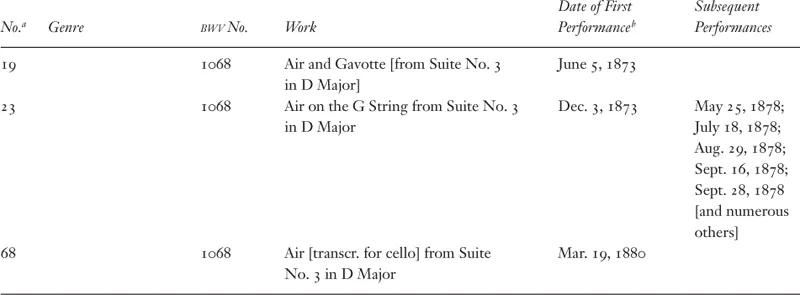![]()
“The Public … Would Probably Prefer Something that Appeals Less to the Brain and More to the Senses”
The Reception of Bach’s Music in New York City, 1855–1900
Mary J. Greer
Asignificant chapter in the history of American performances of Bach’s music begins in New York City. Of the forty chamber, orchestral, and choral compositions by Johann Sebastian Bach that were presented in the United States before 1901, twenty-five received their American premiere in New York. This article provides an overview of the Bach works that were performed in New York between 1855 and 1900 (see the appendix for a chronological list), describes the form in which they were presented, profiles the individuals who played a leading role in promoting his music, and traces the ways in which the attitudes of musicians, critics, and the public toward the composer evolved over the course of these five decades.
The neglect of Bach’s music prior to 1855 is attributable to a combination of factors, some global, some local. Only a small proportion of the repertory was available before 1851, when the publication of the first edition of his complete works commenced. Few American musicians were equal to the technical demands posed by his compositions. There was no call for performances of his music on the part of critics or the public for, to the extent that Bach’s name was familiar at all, it was almost universally associated with music that was old-fashioned and cerebral. Above all, no one had stepped forward to champion his music.
Circumstances became more auspicious for the performance of Bach’s music in New York beginning in the mid-1850s, when several of the city’s leading musicians founded a chamber music series devoted to serious classical repertory. Among the players was the German-born violinist Theodore Thomas (1835–1905) who, initially in his capacity as a soloist and chamber musician, and later as a conductor and arranger, did more than any other individual to promote Bach’s music in New York. Another German immigrant, Leopold Damrosch (1832–85), also played a leading role in introducing Bach works to New York audiences. In 1873 he founded the Oratorio Society which, over the course of the next three decades, presented the New York premieres of both the St. Matthew Passion (in 1880) and the B Minor Mass (in 1900).
The appearance of successive volumes of Bach’s complete works between 1851 and 1899 made many compositions available for study and performance for the first time. Another significant development was the publication in the 1870s and 1880s of Philipp Spitta’s monumental study of Bach, which provided a wealth of new information about the composer’s life and works and the performing conditions of his time.
Overview of Bach Repertory Performed in New York between 1855 and 1900
The overall picture of performances of Bach’s music during the latter half of the nineteenth century is decidedly mixed (see table 1 for Bach works performed in New York, ordered according to genre). On the one hand, nearly all types of pieces—organ works, pieces for other solo keyboard instruments, chamber works, concertos, orchestral compositions, sacred and secular cantatas, motets, Masses, passions, oratorios, and four-part chorales—had been performed at least once in New York by the end of 1900. However, many of these genres were represented by only one or two works, and received only a single performance. Organ works and chamber pieces were frequently presented in the form of orchestral transcriptions rather than as Bach originally conceived them.
Table 1. Works by J. S. Bach Performed on Chamber, Symphonic, and Choral Programs in New York City, 1855–1900, in Order of BWV
Numbers in this column refer to the numbers in the appendix (pp. 106–14).
AmPr = American premiere.
Furthermore, only about forty-two pieces or extended sections of works by Bach—a small fraction of the surviving repertory—were performed in the city during the nineteenth century. There are also surprising gaps: there are no records of any performances of the St. John Passion, the Easter or Ascension Oratorios, the Magnificat, or any of the Lutheran Masses. Only eight of the 200 surviving sacred cantatas were presented in complete or near-complete form. Nonetheless, in comparison to other major American cities, New York was the leader in performances of Bach’s music.
Bach performances in New York evolved in three phases that correlate closely with the founding of various instrumental and vocal ensembles. Between 1856 and 1864 only solo and chamber works, or solo pieces arranged for a chamber ensemble, were presented under the auspices of the Mason-Thomas Chamber Series. During the next eight years (1865–73), nearly all the Bach works that were performed appeared on Theodore Thomas’s symphony programs and consisted of orchestral pieces or transcriptions of organ or chamber compositions. The founding of the Oratorio Society in 1873 led to more regular performances of Bach’s sacred choral repertory. Symphonic performances of Bach works continued through the end of the century.
The Mason-Thomas Chamber Music Series and the Music of Bach, 1856–64
Between 1856 and 1864 two concertos by Bach and three works for violin, or violin and piano, were presented on programs of the Mason-Thomas Chamber Music Series (see table 2). Accounts of these early performances reveal that Bach’s compositions held little appeal for contemporary listeners and were chiefly of historic interest. After attending the American premiere of the Triple Concerto in D Minor in February 1856, the music commentator for the Times observed:
Table 2. Works by Bach Performed at the Mason-Thomas Chamber Concerts, 1856–64
| Date | BWV No. | Work | Performers |
| Feb. 26, 1856 | 1063 | Concerto in D Minor for Three Pianos | William Scharfenberg, Henry C. Timm, and William Mason, pianos; Bergmann, Thomas, Mosenthal, Matzka, and Preusser, strings |
| Apr. 10, 1858 | | | Same performers |
| Apr. 17, 1858 | 1004/5 | Chaconne (with piano accomp. by Mendelssohn) | Theodore Thomas and William Mason |
| Nov. 23, 1858 | | (piano accomp. by Schumann) | Theodore Thomas and prob. William Mason |
| Apr. 14, 1860 | | [with piano accomp.] | Theodore Thomas |
| Mar. 24, 1863 | 1016 | Sonata No. 3 in E Major for Violin and Piano | Theodore Thomas and William Mason |
| Apr. 21, 1863 | 1061 | Concerto in C Major for Two Claviers | Henry C. Timm and William Mason, soloists |
| Mar. 8, 1864 | 1018 | Sonata No. 5 in F Minor for Violin and Piano | Theodore Thomas and William Mason |
The final novelty—Bach’s Concerto, … a hale [and] hearty old patriarch, who is not ashamed of his age and his old fashioned ways … [is] more of a curiosity than an enjoyment. It is very old and very respectable. … [A]lthough we think that the collusion of three pianos with five stringed instruments is an abominable and malicious conspiracy, … it was admirably performed by Messrs. Scharfenberg, Timm, Mason, Bergmann, Thomas, Mosenthal, Matzka and Preusser. Our only regret was that they did not appear in perukes and kneebreeches.
Another reviewer commented that, in his experience, Bach’s “music … is so liable ...
